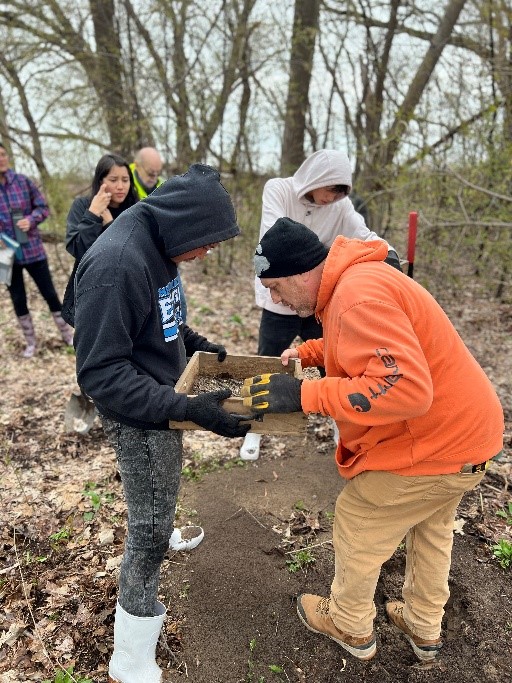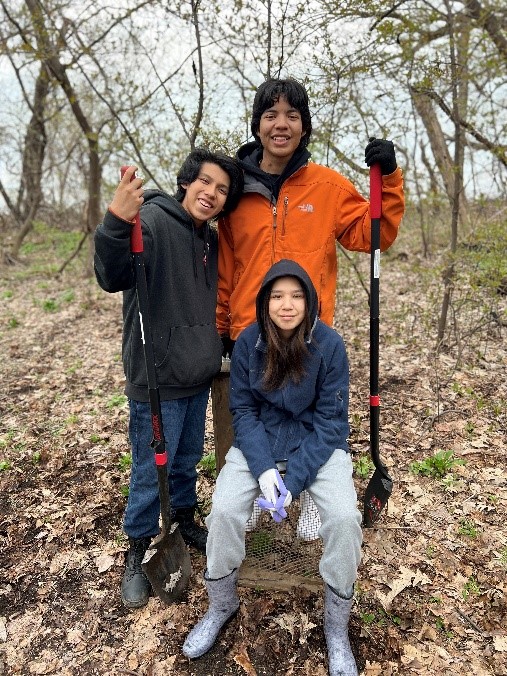By Margaret Ellis – Yotsi’nahkwa’talihahte (Wild Rose), Oneida Nation
University of Wisconsin-Green Bay First Nations Graduate Assistant, Wisconsin Sea Grant
Wequiock Creek Natural Area is one of six places managed by the University of Wisconsin – Green Bay (UWGB). Other areas include the Cofrin Memorial Arboretum and Point au Sable.
In the early stages of the management and restoration of the Wequiock Creek Natural Area, David Overstreet was hired to work with the Wisconsin Department of Natural Resources to identify interested parties to the land and to conduct an archaeological dig. Overstreet is a consulting archaeologist for the Menominee Indian Tribe of Wisconsin and has been doing cultural digs such as this one for many years. The area is the original homeland to many First Nations: Menominee Tribe of Indians of Wisconsin, Ho-Chunk Nation, Potowatomi and Oneida Nation of Wisconsin. At this point, UWGB knew it had to bring the Indigenous voice back to the lands to ensure any restoration efforts incorporated its original inhabitants.

Consulting Archaeologist David Overstreet, works with Menominee youths on Point au Sable in Green Bay. Image credit: Margaret Ellis
One such effort to bring the voice back is to connect Indigenous youth to the area. Overstreet and Bobbie Webster, the natural areas ecologist from the UWGB Cofrin Center for Biodiversity, hosted an archeological dig at Point au Sable this spring. The Point au Sable area is an important site to the Menominee Nation as it is the ancestral and ceded territories of the Menominee Nation. There are references in surveyor notes from early 1800 to Menominee, Ho-Chunk, Potawatomi and others.
Point au Sable was always a popular spot. We also know Chief Lamotte had a residence at Bay Settlement when he signed the Menominee Treaty of 1831. The goal of the dig was to find any artifacts that may be from Menominee ancestors so they can be analyzed and protected from any further restoration efforts and movement of lands. The dig was also a means of connecting Menominee youth with their original homelands and historical items.
This was the second year that Overstreet organized the dig with Menominee Indian High School students at the tip of Point au Sable, about a mile walk out into the bay of Green Bay. The students were led by Christine Fossen-Rades, a science educator at the Menominee Indian High School. After a quick visit to Wequiock Falls, the students met at Point au Sable.
Overstreet and his son, Ryan, marked off archaeological sites prior to the dig so that once everyone arrived, the students could just grab their shovels and sifters and trek the mile to the dig site. They were asked to dig holes to a certain depth or until they hit darker soil. They then used shaker boxes made of screen mesh to sift the soil and sand. The items they were looking for included important artifacts such as cracked rocks, bones, coal and any other objects that may have come from the original inhabitants. Overstreet educated them in the process of bagging items of interest and labeling them so he could bring them to his lab for analysis. The Menominee youth and Tribe are a big part of this process and benefit from any research and lab results.

Menominee Indian High School students helped uncover the past on Point au Sable in Green Bay. Image credit: Margaret Ellis.
My favorite part about this activity was seeing the elements of past, present and future — Menominee students working on lands that belonged to their ancestors in an effort to support the preservation of their culture while using modern-day science. The activity represented an Indigenous worldview of continuity and the circular nature of our being. Experiencing this connection to the past felt like coming full circle and I’m glad to have been involved in it.
This dig is part of an ongoing effort to bring Indigenous voices and presence to UWGB natural areas. As an Indigenous person and UWGB student, I appreciate the movement toward a more inclusive as authentic relationship between UWGB, its natural areas, and the Indigenous Nations that once called them home.


